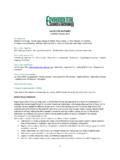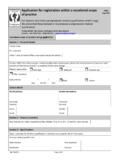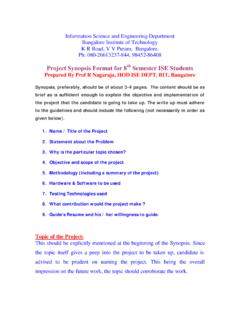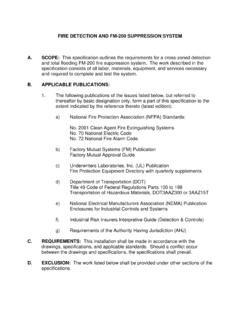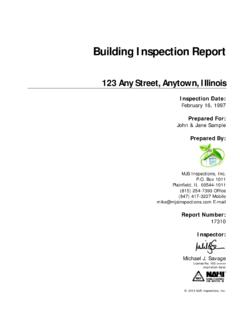Transcription of MX-ONE System Description
1 MX-ONE System Description Copyright Copyright Ericsson AB 2007. All rights reserved. Disclaimer No part of this document may be reproduced in any form without the written permission of the copyright owner. The contents of this document are subject to revision without notice due to continued progress in methodology, design and manufacturing. Ericsson shall have no liability for any error or damage of any kind resulting from the use of this document. Abstract Contents 1 Introduction Scope Glossary 2 System Overview General MX-ONE Telephony System Netwise CMG Application Suite MX-ONE Messaging MX-ONE Manager 3 Key Features 4 Architecture MX-ONE Telephony System Netwise CMG Application Suite MX-ONE Messaging MX-ONE Manager Terminals and User Applications High Availability Scalability Networking Capabilities 5 Interfaces and Protocols 6 Migration 7 Operation and Maintenance General Fault Management Configuration Management Accounting Management Quality of Service Performance Management Security Management 8 Security 9 Capacity MX-ONE Telephony System MX-ONE Messaging 10 Environmental Conditions General Climatic Environment Electromagnetic Compatibility.
2 Safety and Telecom 1 Introduction MX-ONE is a communication System for enterprises. MX-ONE integrates voice and data, fixed and mobile communication, as well as public and private services. It is designed to fit into the existing infrastructure of an enterprise Local Area Network (LAN), thereby saving the cost of operating an additional network for voice. MX-ONE comes with large networking capabilities and an Operation and Maintenance (O&M) function that complies with IS/IT common practices. The distributed architecture of MX-ONE makes it a flexible solution, able to scale from 100 to 45,000 users. Using Ericsson's IP networking or ISDN/Q-SIG+ networking (including VAPA services), multiple MX-ONE systems can be networked to create solutions for even larger or geographically dispersed customers. For the user, the MX-ONE System offers the same user experience as the classic circuit-switched Private Branch Exchange (PBX).
3 Number dialing and terminal interaction is the same with the same array of services and functions and most well-known features and services are available for the user through wired IP phones and mobile phones. The MX-ONE System provides features for the users' daily communication, including user management of activities and profile settings, as well as features for voice mail and fax mail. The MX-ONE System provides the enterprise with a stepwise migration from a circuit-switched PBX into a converged voice and data network. This release of MX-ONE supports a migration of MX-ONE Telephony System - Telephony Switch System to an MX-ONE System . For customers migrating from the Telephony Switch to MX-ONE , the application suite is the recommended option for management and end users applications. For Voice Over IP (VoIP) communication, MX-ONE supports both ITU-T and IETF Session Initiation Protocol (SIP) open standards.
4 MX-ONE provides full functionality in the Ericsson IP phones and the Personal Assistant PC. Basic functionality is available for other IP terminals. MX-ONE supports SIP signaling on both the extension side and trunk side. The SIP solution in MX-ONE offers basic call functionality including caller ID/name DTMF digit signaling. The purpose of the SIP solution is to enable communication with third party products, for example, video conferencing systems. Scope This document provides a high-level Description of the MX-ONE System . It includes a brief Description of the System components, the network architecture, and external interfaces together with general feature descriptions for the MX-ONE System . In this context, the term user is defined as an end-user within the enterprise that uses the MX-ONE System for daily communication. The user can access the MX-ONE System through several different terminals or applications.
5 Thus, each user can have several extensions, for example, one extension for fixed telephony and one for mobile telephony. Throughout this document there will be references to other documents that provide more detailed information about different subjects. For information about how to implement MX-ONE in your IP network, see the Description for MX-ONE System PLANNING. For information about telephony features and capacity data, see the Description for feature LIST and see the Description for CAPACITIES. Glossary For a complete list of abbreviations and a glossary, see the Description for ACRONYMS, ABBREVIATIONS AND GLOSSARY. 2 System Overview General Figure 1 Building blocks of the MX-ONE System The MX-ONE System consists of a set of building blocks used to build a communication solution for the enterprise, see Figure 1: MX-ONE Telephony System is the IP-based and server-based "engine" and the major building block.
6 It supports the Dynamic Network. MX-ONE Messaging provides features for voice mail and fax mail. Netwise Contact Management (CMG) is an advanced contact management System for telephony. It is the recommended user management solution for new customers. Dynamic Network Administration ( ) is an alternative to Netwise CMG. The application suite is the recommended user management solution for customers that are migrating from the Telephony Switch to MX-ONE MX-ONE Manager is used to manage the MX-ONE System . MX-ONE Manager provides administrators ease of use and integrates with the existing IT environment. MX-ONE Telephony System MX-ONE Telephony System provides business class telephony features. It performs call control, call-signaling, and media transcoding and conversion functions. MX-ONE Telephony System can, in various configurations, support IP, mobile, analog, digital, cordless, CAS and ISDN S0 extensions, as well as paging equipment.
7 MX-ONE Telephony System has the following capabilities: Provides traditional PBX functionality Acts as gatekeeper and SIP server, and a media gateway Acts as a gateway towards private and public telephony networks, both fixed (PSTN) and mobile (PLMN) Offers a wide range of telephony features Netwise CMG Application Suite Netwise CMG Application Suite consists of a number of applications for operating and managing an MX-ONE Telephony System . It is the recommended solution for MX-ONE . The CMG suite includes all necessary applications for contact management systems. The CMG suite comprises the product areas: Advanced Operator Console Presence and Availability Management Call Control and Team Collaboration Visitor management The application suite is a comprehensive family of graphic, PC-based programs and utilities supporting PBX operation and administration. It is the recommended solution for customers migrating from a Telephony Switch System .
8 Provides PBX operational support in the following major areas: Operator Call Management Extension Management Directory Management High-level Telecommunications Network Supervision Traffic Measurement and Reporting Event Management For detailed information about , see the technical guide for DYNAMIC NETWORK ADMINISTRATION MX-ONE Messaging MX-ONE Messaging provides the features and applications used for voice mail and fax mail. MX-ONE Messaging has the following capabilities: Offers an efficient and easy-to-use voice mail System that is integrated with MX-ONE Telephony System Provides a fax server function that interacts with MX-ONE Telephony System Allows integration of the above-mentioned functions with collaboration services (Unified Messaging) MX-ONE Manager MX-ONE Manager provides the management functions for the MX-ONE System in accordance with the Fault, Configuration, Accounting, Performance, and Security Management (FCAPS) paradigm.
9 MX-ONE Manager has the following capabilities: Enables configuration and operation of the MX-ONE System Provides a common, single point of entry for user and extension administration Provides advanced fault and performance management that is easy to integrate with existing tools or frameworks Provides consistent management user interfaces across the MX-ONE components and applications Enables automatic software update and distribution within the MX-ONE System 3 Key Features Scalability from 100 to up to 45,000 users using a mix of IP, mobile, digital, analog, cordless, CAS and ISDN S0 extensions. Mobile extension - Uses a 2G or 3G phone connected to the PBX just like any other office extension. Simplified network infrastructure cuts costs by connecting IP extensions with IP phones or IP clients over the LAN, seamlessly extending features to multiple sites through IP connectivity.
10 IP trunking enables a business to optimize network bandwidth and reduce network costs. Open server architecture - MX-ONE runs on off-the-shelf operating systems and commercially available hardware servers. Business class telephony features with the most complete telephony feature offering for medium and large enterprises. No business has to make compromises on how to process critical customer calls. Full suite of applications, including Netwise CMG user applications, Netwise Netwise Operator Worksation (NOW), voice messaging, and Unified Messaging, enables businesses to streamline costs, be more productive, and better serve customers. High Availability - MX-ONE offers high availability by supporting both network and server redundancy. 4 Architecture The MX-ONE System comprises MX-ONE Telephony System that serves the core voice traffic,Netwise CMG Application Suite for personal communication and preference setting, MX-ONE Messaging for voice mail and fax mail, and MX-ONE Manager for user and System management.

